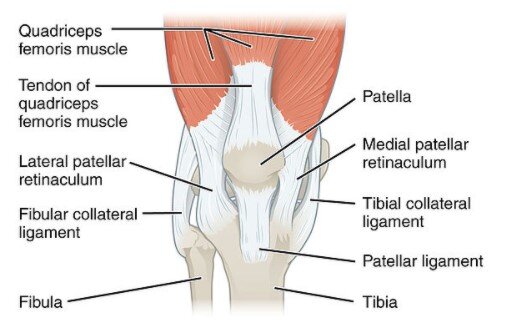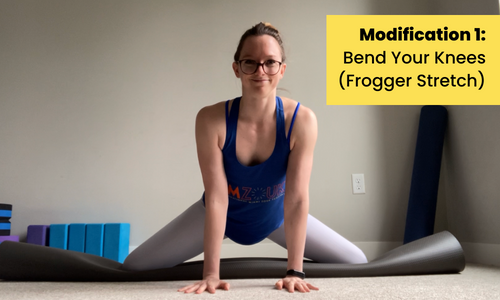Knee Pain in Middle Splits? Try These Adjustments
Knee Pain in Middle Splits? Try These Adjustments
If you experience knee pain when practicing your middle splits, you’re not alone. It’s not uncommon for new practitioners to feel some discomfort in their knees - and I’m not talking about “good stretch” discomfort. So you’re wise to learn what’s going on to fix this issue!
Note: This post isn’t meant to diagnose the cause of your knee pain, but rather to give you knee-friendly options for middle split stretches you can continue to work on without pain.
Super Quick Knee Anatomy Overview
There are a couple of things helpful to understand about our knees when it comes to middle splits.
The knee is a modified hinge joint (if you want to nerd out about the anatomy, this Kenhub article is great) - and as a hinge joint it’s only meant to bend in one plane of motion.
There are several structures that cross the knee joint and help keep it safe and functioning effectively:
Image Credit: OpenStax College / CC BY (https://creativecommons.org/licenses/by/3.0)
There are a whole slew of ligaments, collagenous fibers that connect bone to bone. Some connect your thigh bone to your shin bone(s), others connect your thigh and shin bone to your patella (kneecap)
There are several muscles and tendons that cross the knee joint, including your hamstrings, quadriceps, popliteus (the little muscle that helps unlock your knee!), gastrocnemius (calf muscle), the IT band, and others…
All of that to say - there’s a lot going on in your knee trying to support the joint, so there are a lot of potential causes of why you might be feeling knee pain. One of the most common is that the muscles around our knee just aren’t quite strong enough yet to protect against the downward shearing force that pushes the inside of our knee toward the floor in a middle split (which is not a direction our knee is designed to bend!). So giving our knees some support, or lessening that force, is a great potential way to make the stretch more comfortable while your muscles get used to supporting this new range of motion.
How to Avoid Knee Pain In Middle Splits
Possible Fix #1: Bend Your Knees (Frogger Stretch)
This is probably the easiest (and most common) fix - bend your knees! Instead of doing a full middle splits with both legs straight, which can sometimes put a lot of shearing stress on the knee pressing it in a direction it’s not meant to bend, bend both knees to come into your frogger stretch.
For your frogger stretch, both knees should be bent 90 degrees, and knees in line with your hips. You’ll still get a great stretch for your inner thigh muscles.
If the insides of your knees are sensitive, you can roll your yoga mat a couple of times, or put pillows or a rolled up blanket under each knee for some extra cushion.
Possible Fix #2: Physically Support Your Knees with Blocks
A similar solution to take pressure out of the knee joint is to physically support the knees with a prop. Yoga blocks, some pillows, or a rolled up blanket can work great. I like yoga blocks because you can easily adjust the height to make them taller/shorter to account for a variety of flexibility levels.
I really like coupling this knee support variation with the frogger stretch (assuming this one feels OK for your knees!) because it stretches our inner thigh muscles differently. Most of our inner thigh muscles run from our hip bones to the inside of the thigh bone, but one muscle (the gracilis) runs from our hip bone all the way past our knee to one of our shin bones, and it gets more of a stretch when our legs are straight in a middle split vs. when they are bent in a frogger. So it’s nice to include both bent leg and straight leg work (if your knees will allow) when stretching for your middle splits.
Possible Fix #3: Do Your Middle Split Upside Down (at a Wall)
Finally, this is one of the gentlest variations of a middle split because you no longer have the whole of your body weight pushing into your hips and knees - do your middle splits upside down!
For legs-up-the-wall, scoot your butt close to the wall and straddle your legs out to the side as far as is comfortable - that’s it!
If the stretch feels too intense in your inner thighs, you can place blocks under the outside of your thighs to support some of the weight of your legs.
When to See a Professional
If none of these modifications work for you, or you have persistent knee pain that doesn’t go away even after working on some of the gentler stretches over the course of a month, it might be time to see a pro. Because there are so many potential causes for knee pain (tight muscles, weak muscles, unengaged muscles, lax ligaments, boney structure issues, nerve tension - the list goes on…), it may be worthwhile to make an appointment with a physical therapist or qualified flexibility coach to try and identify the cause of ongoing knee pain in your body.





